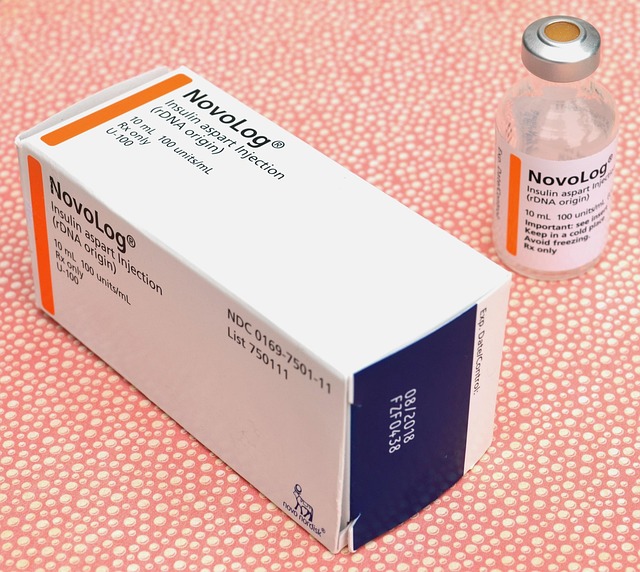Semaglutide, a groundbreaking GLP-1 receptor agonist, offers a revolutionary semaglutide diabetes treatment for type 2 diabetics. By mimicking natural gut hormones, it effectively lowers HbA1c levels and enhances insulin secretion, providing superior blood sugar control compared to traditional medications. Its once-weekly injection, starting at 0.5 mg, allows for tailored dosing under medical supervision. While common side effects like gastrointestinal issues may occur, serious complications are rare but require monitoring. Ongoing clinical trials aim to expand its effectiveness and safety profile, potentially transforming diabetes management guidelines in the future.
Semaglutide, a groundbreaking medication, has emerged as a powerful tool in managing type 2 diabetes. This article explores its role in reducing HbA1c levels—a key marker of long-term blood sugar control. We delve into the science behind semaglutide, its mechanism of action, and how clinical trials have demonstrated its efficacy. From potential benefits to administration details and side effects, this comprehensive guide provides insights into why semaglutide is revolutionizing diabetes treatment, offering hope for improved glycemic control.
What is Semaglutide?

Semaglutide is a groundbreaking medication that has made significant waves in the field of diabetes management, particularly as a novel diabetes treatment. It belongs to a class of drugs known as glucagon-like peptide-1 (GLP-1) receptor agonists. This synthetic compound mimics the effects of a natural hormone produced by your gut after eating, stimulating insulin production and suppressing glucagon secretion. By doing so, semaglutide helps lower blood sugar levels, making it an effective tool in the fight against diabetes.
As a GLP-1 receptor agonist, semaglutide has shown remarkable potential in reducing HbA1c (hemoglobin A1c) levels—a key marker of long-term blood sugar control. Its ability to enhance insulin secretion and reduce glucagon release makes it an innovative solution for type 2 diabetes patients who require better glycemic management. With its once-weekly administration, semaglutide offers a convenient and potentially life-changing option for those seeking to improve their diabetes treatment outcomes.
Understanding HbA1c Levels and Diabetes Management

Hemoglobin A1c (HbA1c) levels offer a crucial indicator of long-term blood sugar control in individuals with diabetes. This biomarker represents an average glucose level over the past 2 to 3 months, providing essential insights into glycemic management. For people living with diabetes, maintaining healthy HbA1c levels is vital for preventing complications associated with elevated blood sugar, such as nerve damage, kidney disease, and cardiovascular issues. Semaglutide, a groundbreaking semaglutide diabetes treatment, has emerged as a powerful ally in this endeavor.
By mimicking the action of a natural hormone, semaglutide helps regulate insulin release and suppresses glucose production in the liver, leading to significant reductions in HbA1c levels. This multi-faceted approach not only improves glycemic control but also contributes to weight management, another critical aspect of diabetes care. As a result, semaglutide has become an increasingly popular choice in the arsenal of diabetes treatments, offering hope for those striving to manage their condition effectively and reduce the risk of associated health complications.
Semaglutide's Mechanism of Action in Lowering HbA1c

Semaglutide, a glucagon-like peptide-1 (GLP-1) receptor agonist, has revolutionized the management of type 2 diabetes. Its primary mechanism of action involves mimicking the natural effects of GLP-1, a hormone produced by the gut in response to food intake. By activating GLP-1 receptors, semaglutide stimulates insulin secretion from the pancreas in a glucose-dependent manner, ensuring a balanced insulin response based on blood sugar levels.
This drug also promotes satiety, leading to reduced food intake and subsequent lowering of blood glucose. The dual action of enhancing insulin release and decreasing glucagon production contributes significantly to its effectiveness in reducing HbA1c (hemoglobin A1c) levels—a key marker of long-term glycemic control. In the context of semaglutide diabetes treatment, these mechanisms collectively work to stabilize blood sugar levels, offering a more manageable and potentially cure-like solution for individuals with type 2 diabetes.
Clinical Trials and Their Results: Semaglutide's Efficacy

Clinical trials have played a pivotal role in highlighting Semaglutide’s potential as a powerful diabetes treatment. These studies, conducted across diverse populations, consistently demonstrated its efficacy in significantly reducing HbA1c levels. Participants in these trials experienced improved glycemic control, with many achieving target HbA1c ranges that were previously hard to attain. The results showed that Semaglutide not only lowers blood sugar but also helps maintain stable levels, offering a promising alternative to conventional diabetes management.
These clinical trials have been instrumental in understanding the mechanism of action of Semaglutide, a glucagon-like peptide-1 (GLP-1) receptor agonist. By mimicking the effects of natural GLP-1, it stimulates insulin secretion and suppresses glucagon release, leading to enhanced insulin sensitivity. The trials’ positive outcomes have led to widespread adoption of Semaglutide in diabetes treatment protocols, providing hope for improved quality of life and reduced long-term complications for patients living with this chronic condition.
Potential Benefits of Semaglutide for Diabetic Patients

Semaglutide, a novel glucagon-like peptide-1 (GLP-1) receptor agonist, offers significant potential as a diabetes treatment. Its primary benefit lies in its ability to reduce hemoglobin A1c (HbA1c) levels, providing a more stable and controlled blood sugar management for diabetic patients. This is particularly advantageous for those struggling to maintain optimal HbA1c ranges through lifestyle changes or conventional medications alone.
Beyond HbA1c reduction, semaglutide can lead to substantial weight loss, making it a promising tool in combating the obesity often associated with type 2 diabetes. Its appetite-reducing effects and increased feelings of fullness can foster healthier eating habits and support long-term metabolic control. As a result, semaglutide presents a potential game-changer in diabetic management, offering both improved glycemic control and weight management benefits for patients seeking more effective and comprehensive care.
How Semaglutide Compares to Other Diabetes Treatments

Semaglutide has emerged as a powerful tool in the management of type 2 diabetes, offering significant advantages over traditional diabetes treatments. Compared to other oral antidiabetic medications, semaglutide provides superior control of blood sugar levels, particularly in reducing HbA1c (hemoglobin A1c). One key differentiator is its mechanism of action; while many existing drugs focus on enhancing insulin secretion or inhibiting glucose absorption, semaglutide mimics the effects of the natural hormone GLP-1, stimulating insulin release and suppressing glucagon. This dual action results in more consistent blood sugar control.
In head-to-head comparisons, clinical trials have shown that semaglutide consistently outperforms other diabetes treatments in lowering HbA1c levels. It offers a more sustained effect, making it an attractive option for patients who struggle to maintain optimal blood sugar control with conventional medications. Moreover, semaglutide has been linked to weight loss benefits, which is a significant advantage considering the high prevalence of obesity among individuals with type 2 diabetes. This multi-faceted approach positions semaglutide as a promising and effective solution in the ongoing battle against diabetes.
Administering Semaglutide: Injection and Dosage Information

Semaglutide, a medication primarily known for its role in diabetes management, is administered via subcutaneous injection, offering a convenient and effective way to control blood sugar levels. The dosage of semaglutide is typically determined by a healthcare provider based on individual patient needs. It is usually prescribed as a once-weekly injection, with the exact dose starting at 0.5 mg and gradually increasing up to 2.4 mg over time. This flexible dosing allows for personalized treatment, ensuring optimal blood sugar control while minimizing side effects.
The injection is administered in the abdominal, thigh, or upper arm areas, with patients typically rotating the injection site each week to prevent skin irritation. It’s essential to follow the prescription and not miss doses, as consistency is key to achieving and maintaining healthy HbA1c levels. Patients should also be aware of potential side effects, such as nausea, vomiting, diarrhea, and weight loss, which are common but usually temporary.
Side Effects and Precautions with Semaglutide Use

Semaglutide, while effective in reducing HbA1c levels as a diabetes treatment, is not without its side effects. Common experiences include nausea, vomiting, and diarrhea, often reported during the initial stages of therapy. These gastrointestinal symptoms usually subside as the body adjusts to the medication. More serious but rare complications may include pancreatitis, kidney problems, or thyroid issues. Patients on semaglutide should be aware of these potential risks and promptly report any concerning symptoms to their healthcare provider.
Precautions are essential when using semaglutide. Individuals with a history of pancreatitis, kidney failure, or thyroid disorders should exercise caution. The medication may also affect blood sugar levels, so close monitoring is crucial, especially for those with diabetes complications. Additionally, semaglutide can cause gallstones and acid reflux; thus, patients should maintain a healthy diet and lifestyle to mitigate these risks. Regular check-ups are recommended to ensure safe and effective treatment.
Future Prospects and Research in Semaglutide Diabetes Treatment

As research progresses, the future of semaglutide in diabetes treatment looks promising. Ongoing and upcoming clinical trials are exploring its potential to lower HbA1c levels even further, with some studies focusing on its efficacy in various patient populations, including those with comorbidities. The long-term safety and tolerability of semaglutide are also being evaluated, aiming to provide a comprehensive understanding of its role in diabetes management.
Future prospects include potential combinations of semaglutide with other antihyperglycemic agents, as well as investigations into its effect on cardiovascular outcomes, which could significantly impact treatment guidelines for diabetes. Additionally, the development of user-friendly administration methods, such as once-weekly or even longer-acting formulations, may enhance patient adherence and compliance, making semaglutide diabetes treatment more accessible and effective in real-world settings.
